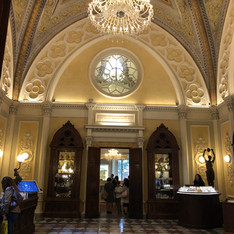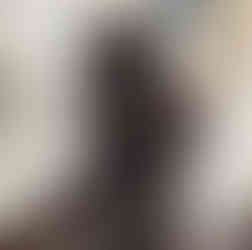Hidden Gem of Florence: Old Pharmacy of Santa Maria Novella
- Lauren Reynolds
- May 17, 2018
- 4 min read
A trip to Florence, Italy is not complete without a trip to the Duomo, the Uffizi, or to see the David. But, it is the hidden gems of a city that can really make the difference in your stay, and that is exactly what Officina Profumo Farmacertica di Santa Maria Novella, or the “Old Pharmacy of Santa Maria Novella” is. Hidden in the back entrance of the Santa Maria de Novella Basilica, is one of the world’s oldest pharmacies with an enchanting story, medieval products to buy, and an experience unlike your typical trip to your local CVS or green neon cross pharmacy.
Behind the Santa Maria de Novella church, on Via de la Scala, is a small and quaint entrance reading “Officina Profumo Farmacertica.” But this modest entrance is nothing like what waits for you inside. Upon entering you are greeted by a long corridor which opens to a room with walls overwhelmed with gilded angels, 18th century motifs, vaulted ceilings, and “a Matteo Nigetti doorway leading to the Antica Speziera” which reminds you that you are still in fact in the former monastery of the Santa Maria de Novella Basilica.

The story of this pharmacy begins in the 1200s, when Dominican monks migrated to the city of Florence in 1221. At this time, the monks would garden and harvest herbs for medicinal remedies in the forms of balms and pomades. It was not until the 1600s when the remedies gained fame that the pharmacy was opened to the public. Catherine Medici, an Italian aristocrat and Queen of France after her marriage to King Henry II, commissioned these monks to make her signature perfume. The citrus based scent is still sold at the pharmacy as “Acqua della Regina” or “Water of the Queen.” This first celebrity fragrance upon Catherine’s marriage to the King laid “the foundation of the French and Italian fragrance industry.”
By 1800, this pharmacy and its products had expanded internationally to counties all over Europe such as England and Russia. But in 1866, upon the confiscation of the churches assets by the Italian government, the pharmacy was made into a state owned enterprise. It was later ceded to the nephew of the last monastic director, Cesare Augusto Stefani, whose family has been running this business for four generations and has expanded the business internationally. If you run out of your favorite product and want more, Santa Maria Novella has five stores in the United States alone in New York, Chevy Chase, Los Angeles, and two in Miami. You can also order your refills on their US website found here. Be warned though, not everything is available for purchase online.

Each counter has its own product category among the rooms, one for perfume, one for soap, another for bath and body products, and lastly one for medicinal remedies. Everything from the packaging of the products, to their formulation, to the architecture of the corridors is something out of a medieval museum. The formula and production of each cosmetic remains consistent to that of its original creation by the monks.
Most people flock to the counters to smell the 54 perfumes on display, or the 4 types of face creams made for every skin type or concern. There is practically every skincare product you could think of including shampoo, deodorant, and cleansers for your furry dog and cat friends. Products range from 6 euro potpourri, to 25 euro cosmetic bags, to 50 euro body milks and, 90 euro perfumes. However, all smells and sampling of the cosmetics are free.
If you do want to live the medieval Italian aristocrat life with a purchase, then there are plenty of amazing best sellers to choose from. Bestselling perfumes include the fruity and soft floral “Angeli de Firenze” or “Angel of Florence” created for the 40th anniversary of the 1966 Florence flood and dedicated to the Mud Angels, youth who flocked to Florence to help in the recovery (90 euros). Another popular product is the body milk made from rose and gardenia that is said to improve skin elasticity (50 euros).
But the shopping experience if it all is what really blows visitors away. Guests wander from room to room sampling the beautifully displayed products as they are surrounded by intricate decorations and art. Once they decide what to bring home, a sales associate asks for their country of origin and gives them a card similar to a hotel room key, which they can bring to every desk and add to their shopping list. Once they are done perusing, they can go to the stock room where the card is scanned and all the products are picked off the shelves and wrapped as you pay.
And there is no fear of a language barrier. While this attraction is off the beaten path, and excluded from most commercialized tourist literature, it still does attract a healthy international audience. Serena, a sales associate who has worked at the pharmacy for three years, describes all the languages she has under her belt saying, “I know Italian, English; [very basic] Spanish, German, and French; and I am currently learning Japanese and Korean.” At the entrance, there is also a menu of all the products sold in a multitude of languages so be sure that there will be little to no difficulty in visiting the site or purchasing products.
But what makes this place so special is not the intricacies of its story or the products sold. It is the way such a small and obscure place can really surprise us and interweave art, fashion and history in such a beautiful and interesting way. Oftentimes we are taken aback by the grand and overwhelming sights featured in our tourist literature, or those which have gained international fame and are featured on the postcards we send home like the many churches and basilicas. Yet, The Old Pharmacy of Santa Maria Novella teaches us that sometimes the brightest gems of our adventures are often the smallest and most difficult to find. Sometimes you have to look closer at a large masterpiece to really enjoy the intricacies and treasures there is to discover.



















Comments